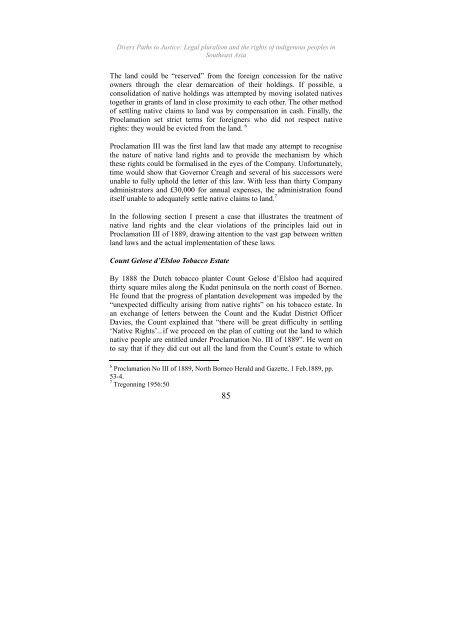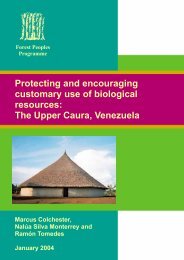Divers Paths to Justice - English - Forest Peoples Programme
Divers Paths to Justice - English - Forest Peoples Programme
Divers Paths to Justice - English - Forest Peoples Programme
You also want an ePaper? Increase the reach of your titles
YUMPU automatically turns print PDFs into web optimized ePapers that Google loves.
<strong>Divers</strong> <strong>Paths</strong> <strong>to</strong> <strong>Justice</strong>: Legal pluralism and the rights of indigenous peoples inSoutheast AsiaThe land could be “reserved” from the foreign concession for the nativeowners through the clear demarcation of their holdings. If possible, aconsolidation of native holdings was attempted by moving isolated natives<strong>to</strong>gether in grants of land in close proximity <strong>to</strong> each other. The other methodof settling native claims <strong>to</strong> land was by compensation in cash. Finally, theProclamation set strict terms for foreigners who did not respect nativerights: they would be evicted from the land. 6Proclamation III was the first land law that made any attempt <strong>to</strong> recognisethe nature of native land rights and <strong>to</strong> provide the mechanism by whichthese rights could be formalised in the eyes of the Company. Unfortunately,time would show that Governor Creagh and several of his successors wereunable <strong>to</strong> fully uphold the letter of this law. With less than thirty Companyadministra<strong>to</strong>rs and £30,000 for annual expenses, the administration founditself unable <strong>to</strong> adequately settle native claims <strong>to</strong> land. 7In the following section I present a case that illustrates the treatment ofnative land rights and the clear violations of the principles laid out inProclamation III of 1889, drawing attention <strong>to</strong> the vast gap between writtenland laws and the actual implementation of these laws.Count Gelose d’Elsloo Tobacco EstateBy 1888 the Dutch <strong>to</strong>bacco planter Count Gelose d’Elsloo had acquiredthirty square miles along the Kudat peninsula on the north coast of Borneo.He found that the progress of plantation development was impeded by the“unexpected difficulty arising from native rights” on his <strong>to</strong>bacco estate. Inan exchange of letters between the Count and the Kudat District OfficerDavies, the Count explained that “there will be great difficulty in settling‘Native Rights’...if we proceed on the plan of cutting out the land <strong>to</strong> whichnative people are entitled under Proclamation No. III of 1889”. He went on<strong>to</strong> say that if they did cut out all the land from the Count’s estate <strong>to</strong> which6 Proclamation No III of 1889, North Borneo Herald and Gazette, 1 Feb.1889, pp.53-4.7 Tregonning 1956:5085
















